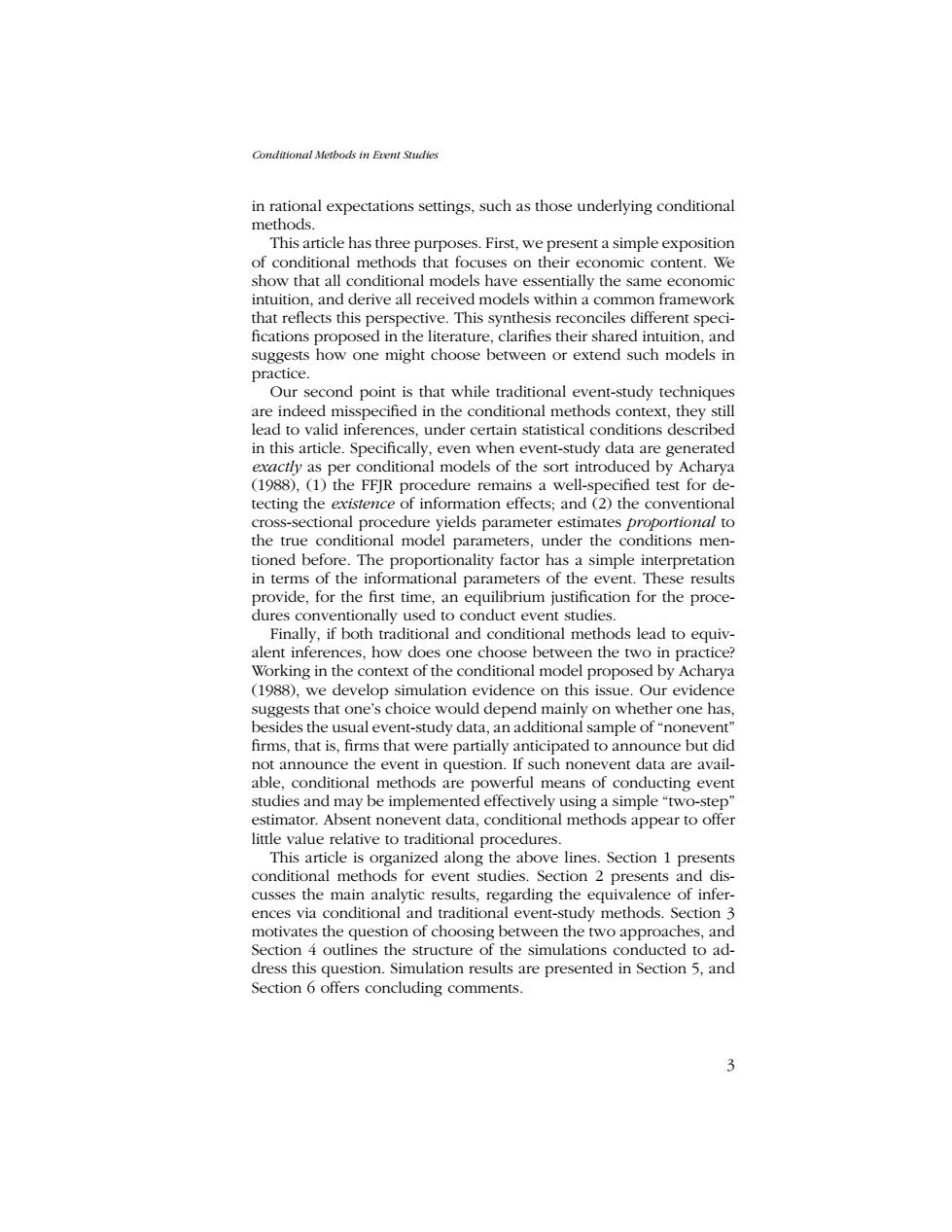正在加载图片...

Conditional Metbods in Event Studies in rational expectations settings,such as those underlying conditional methods. This article has three purposes.First,we present a simple exposition of conditional methods that focuses on their economic content.We show that all conditional models have essentially the same economic intuition,and derive all received models within a common framework that reflects this perspective.This synthesis reconciles different speci- fications proposed in the literature,clarifies their shared intuition,and suggests how one might choose between or extend such models in practice. Our second point is that while traditional event-study techniques are indeed misspecified in the conditional methods context,they still lead to valid inferences,under certain statistical conditions described in this article.Specifically,even when event-study data are generated exactly as per conditional models of the sort introduced by Acharya (1988),(1)the FFJR procedure remains a well-specified test for de- tecting the existence of information effects;and (2)the conventional cross-sectional procedure yields parameter estimates proportional to the true conditional model parameters,under the conditions men- tioned before.The proportionality factor has a simple interpretation in terms of the informational parameters of the event.These results provide,for the first time,an equilibrium justification for the proce- dures conventionally used to conduct event studies. Finally,if both traditional and conditional methods lead to equiv- alent inferences,how does one choose between the two in practice? Working in the context of the conditional model proposed by Acharya (1988),we develop simulation evidence on this issue.Our evidence suggests that one's choice would depend mainly on whether one has, besides the usual event-study data,an additional sample of"nonevent" firms,that is,firms that were partially anticipated to announce but did not announce the event in question.If such nonevent data are avail- able,conditional methods are powerful means of conducting event studies and may be implemented effectively using a simple"two-step" estimator.Absent nonevent data,conditional methods appear to offer little value relative to traditional procedures. This article is organized along the above lines.Section 1 presents conditional methods for event studies.Section 2 presents and dis- cusses the main analytic results,regarding the equivalence of infer- ences via conditional and traditional event-study methods.Section 3 motivates the question of choosing between the two approaches,and Section 4 outlines the structure of the simulations conducted to ad- dress this question.Simulation results are presented in Section 5,and Section 6 offers concluding comments. 3Conditional Methods in Event Studies in rational expectations settings, such as those underlying conditional methods. This article has three purposes. First, we present a simple exposition of conditional methods that focuses on their economic content. We show that all conditional models have essentially the same economic intuition, and derive all received models within a common framework that reflects this perspective. This synthesis reconciles different speci- fications proposed in the literature, clarifies their shared intuition, and suggests how one might choose between or extend such models in practice. Our second point is that while traditional event-study techniques are indeed misspecified in the conditional methods context, they still lead to valid inferences, under certain statistical conditions described in this article. Specifically, even when event-study data are generated exactly as per conditional models of the sort introduced by Acharya (1988), (1) the FFJR procedure remains a well-specified test for detecting the existence of information effects; and (2) the conventional cross-sectional procedure yields parameter estimates proportional to the true conditional model parameters, under the conditions mentioned before. The proportionality factor has a simple interpretation in terms of the informational parameters of the event. These results provide, for the first time, an equilibrium justification for the procedures conventionally used to conduct event studies. Finally, if both traditional and conditional methods lead to equivalent inferences, how does one choose between the two in practice? Working in the context of the conditional model proposed by Acharya (1988), we develop simulation evidence on this issue. Our evidence suggests that one’s choice would depend mainly on whether one has, besides the usual event-study data, an additional sample of “nonevent” firms, that is, firms that were partially anticipated to announce but did not announce the event in question. If such nonevent data are available, conditional methods are powerful means of conducting event studies and may be implemented effectively using a simple “two-step” estimator. Absent nonevent data, conditional methods appear to offer little value relative to traditional procedures. This article is organized along the above lines. Section 1 presents conditional methods for event studies. Section 2 presents and discusses the main analytic results, regarding the equivalence of inferences via conditional and traditional event-study methods. Section 3 motivates the question of choosing between the two approaches, and Section 4 outlines the structure of the simulations conducted to address this question. Simulation results are presented in Section 5, and Section 6 offers concluding comments. 3